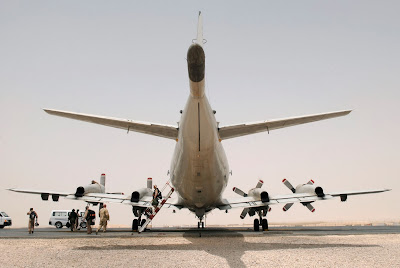Drones Get MAD
No, despite hype to the contrary, drones aren't getting angry and taking over the world. But if the U.S. Navy gets its way, a new generation of Unmanned Aerial Vehicles might be getting Magnetic Anomaly Detectors, or MAD. The Navy has issued two Small Business Innovation Research (SBIR) solicitations related to the incorporation of MAD sensors in UAVs.
A MAD is a device normally found on anti-submarine warfare aircraft that detects changes in the earth's magnetic field caused by a large metal object (i.e., a submarine). MAD sensors can be found in the tail of the P3 or towed behind an aircraft, in the case of the Navy's SH-60B helicopters, and are used in the final stages of target prosecution to pinpoint the submarine before weapons release.
The first SBIR solicitation is entitled "Low Magnetic Signature Expendable Unmanned Aerial Vehicle (UAV) for Anti-Submarine Warfare (ASW)" and the goal of developing a "low magnetic signature, expendable Tier 1 UAV that can be launched from a P-8A or similar military aircraft via the sonobuoy launch system from high altitude, with the capability to carry a sensitive scalar magnetometer for ASW MAD with the requirement that the inherent UAV magnetic noise shall not limit the effectiveness of the MAD sensor." This capability is required because the Navy has recently introduced the P-8A Poseidon (based on Boeing's 737) which cannot perform ASW at altitudes low enough (300-500 feet) to employ a MAD as the existing P-3C does. The solicitation calls for a magnetically quiet UAV equipped with a low-cost Size, Weight and Power (SWaP) magnetometer currently in development. The UAV would also carry a camera in an EO/IR turret system enabling it to distinguish a MAD hit as a surface or subsurface contact. The UAV must fly pre-programmed tracks at 70 knots air speed for at least 70 minutes. Moreover, the system should cost less than $5000 when purchased in quantities of 100. Phases II and III would demonstrate in flight performance of all system features.
 |
| Boeing P-8A Poseidon |
A related solicitation is entitled "Development of Analysis Techniques for Predicting Magnetic Anomaly Detection (MAD) Equipped UAV Performance in Naval Anti-Submarine Warfare Environment."
This effort will develop a software-based Tactical Decision Aid (TDA) that will enable a mission commander to predict the probability of detection of a MAD-equipped UAV against current submarine threats. The tool should consider MAD system performance, magnetic environmental noise, UAV performance, and other factors. Essentially the tool will help the commander to decide whether or not to expend a UAV and orient the search tracks for that UAV to localize the target submarine. Phase One proposals of the solicitations are due by 22 January 2014.
Launching UAVs from an ASW aircraft is not unprecedented. In 2009, an expendable sonobuoy tube-launched UAV called Coyote was tested out a NOAA's WP-3D Orion under an Office of Naval Research. A less successful small business grant was awarded to Lite Machines to modify its Voyeur UAV for sonochute launch.
Launching UAVs from an ASW aircraft is not unprecedented. In 2009, an expendable sonobuoy tube-launched UAV called Coyote was tested out a NOAA's WP-3D Orion under an Office of Naval Research. A less successful small business grant was awarded to Lite Machines to modify its Voyeur UAV for sonochute launch.


We all Knew that US Navy is going to get 117 P-8As to replace P-3Orion which are serving from 1962...
ReplyDeleteMany has this Question, why has the US Navy and Boeing invested so much in the P-8A - a manned platform with operational concepts that date back 50 years?
Here is the answer lies in its capabities
http://www.naval-technology.com/features/feature-p-8-poseidon-adventure-new-era-maritime-aircraft/
it's so cool !!
ReplyDelete